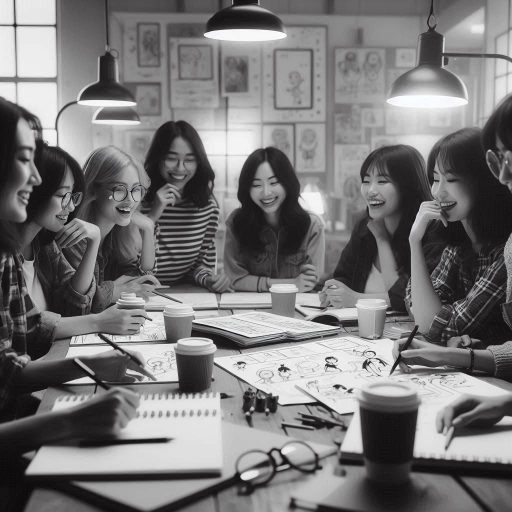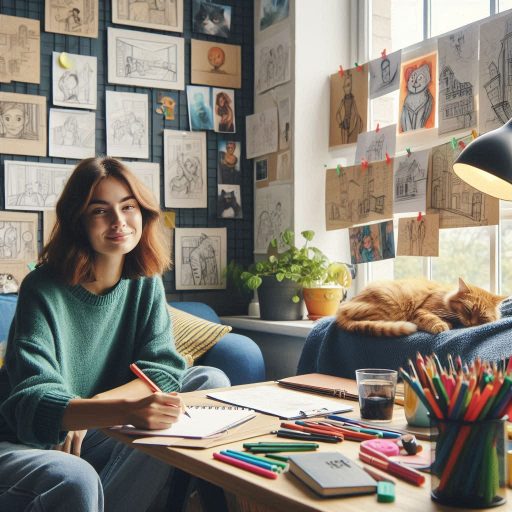Introduction
A storyboard artist plays a vital role in the entertainment industry, shaping visual narratives for film, television, and animation.
This profession requires a unique blend of artistic skills and storytelling abilities, making it essential for any production team.
Storyboard artists create a sequence of drawings that illustrate scenes and actions, providing a visual blueprint that guides filmmakers and animators.
Their work begins with a thorough understanding of the script and the director’s vision.
By translating written words into visual sequences, storyboard artists allow directors and animators to envision how scenes will unfold on screen.
They sketch character movements, camera angles, and emotional expressions, ensuring that every detail aligns with the overall narrative.
This meticulous process fosters clarity and cohesion among the creative team, minimizing misunderstandings during production.
The importance of storyboard artists cannot be overstated.
They serve as the bridge between the script and the final visual product, enabling smoother collaboration among various departments.
By illustrating the narrative’s flow, storyboard artists help streamline the production process, saving time and resources.
Moreover, their contributions are critical for effective storytelling.
A well-crafted storyboard not only visualizes scenes but also evokes emotions, guiding the audience’s experience.
Morning Routine
The Typical Morning Routine of a Professional Storyboard Artist
Most storyboard artists wake up early to maximize their day.
They start their mornings with a healthy breakfast to fuel their creativity.
A balanced meal provides the energy needed for the demanding tasks ahead.
After breakfast, they typically take some time to gather their thoughts.
The first order of business is checking emails.
Artists review messages from clients, directors, and team members.
This step is crucial for staying updated on project developments.
Important emails often contain feedback or changes that require immediate attention.
After reviewing emails, storyboard artists move on to project briefs.
They carefully read through the latest briefs to understand expectations.
This review helps clarify the direction of their current projects.
It ensures they align their storyboards with the overall vision of the production.
Setting daily goals is another essential activity in the morning routine.
Artists take a few moments to outline what they want to achieve.
These goals may include completing specific storyboard sequences or addressing feedback from previous drafts.
By setting clear objectives, artists maintain focus throughout the day.
They prioritize tasks based on deadlines and project importance.
This proactive approach prevents last-minute stress and ensures a steady workflow.
Some storyboard artists incorporate a brief creative exercise into their morning routine.
This exercise might include sketching ideas or brainstorming visual concepts.
Engaging in creative activities helps spark inspiration and enhances their artistic mindset.
Activities Like Checking Emails, Reviewing Project Briefs, and Setting Goals for the Day
Once the morning planning is complete, artists dive into their work.
They often start by tackling the most challenging scenes first.
This approach allows them to leverage their peak energy levels for complex tasks.
As the day progresses, storyboard artists collaborate with other team members.
They may have meetings with directors to discuss visual direction and project updates.
Effective communication is vital in ensuring everyone is aligned on creative objectives.
Artists also spend time revising storyboards based on feedback.
They may redraw certain panels to better convey emotions or actions.
This revision process is crucial for refining their work and enhancing the overall narrative.
Therefore, a professional storyboard artist’s morning routine involves structured activities that promote productivity.
They start by checking emails, reviewing project briefs, and setting goals.
Engaging in creative exercises can further enhance their focus and inspiration.
By following this routine, storyboard artists prepare themselves for a successful and fulfilling day in the world of visual storytelling.
Read: Famous Costume Designers in Hollywood
Collaboration with Team Members
How Storyboard Artists Collaborate With Directors, Producers, and Other Team Members
A professional storyboard artist plays a crucial role in the creative process.
Collaboration with directors, producers, and team members is essential for success.
During pre-production, storyboard artists meet with directors to discuss the overall vision for the project.
These discussions help clarify the story, tone, and visual style that the director wants to achieve.
Storyboard artists also engage with producers to understand budget constraints and timelines.
Producers provide essential information about the production schedule and resources available.
This collaboration ensures that the storyboard aligns with the project’s goals and limitations.
Throughout the process, storyboard artists work closely with other team members, such as animators and designers.
By sharing ideas and receiving feedback, they refine their storyboards.
Collaboration fosters an environment where creativity can thrive and ideas can flow freely.
Regular meetings and check-ins help maintain communication among the team.
Storyboard artists present their work to directors and producers to get feedback.
This ongoing dialogue allows artists to make adjustments based on input from key stakeholders.
The Process of Interpreting and Translating the Director’s Vision Into Visual Representations
Translating a director’s vision into visual representations requires skill and intuition.
Storyboard artists begin by studying the script closely.
They analyze key scenes, character motivations, and emotional beats to understand the narrative fully.
After grasping the story, artists sketch rough thumbnails to visualize their ideas.
These initial sketches focus on composition, camera angles, and character placement.
The goal is to convey the essence of each scene effectively.
Once the thumbnails are complete, storyboard artists present them to the director.
Feedback during this stage is vital for ensuring alignment with the director‘s vision.
Artists incorporate revisions to refine the storyboards based on the director’s comments.
As the process continues, artists create more detailed storyboards.
These drawings include finer details like facial expressions, backgrounds, and action sequences.
Each frame helps visualize the pacing and flow of the scenes, providing a clear roadmap for production.
Storyboards often include notes about camera movement and dialogue.
These annotations help convey the technical aspects of each shot, guiding the production team during filming.
Throughout this process, storyboard artists must remain adaptable.
Directors may change their vision as the project evolves, requiring artists to revise their work.
Staying flexible and open to new ideas is crucial for success in this role.
Ultimately, the collaboration between storyboard artists and the creative team shapes the final product.
By interpreting and translating the director’s vision into visual representations, storyboard artists play a key role in bringing stories to life.
Their work serves as a foundational blueprint for the entire production, ensuring a cohesive and compelling narrative.
Read: Essential Skills for Aspiring Costume Designers
Sketching and Storyboarding Process
The step-by-step process of sketching and storyboarding a scene
A professional storyboard artist begins each day with a clear plan.
They review project notes and scripts to understand their goals.
This helps them visualize the scenes they need to create.
The first step in sketching a scene is brainstorming ideas.
The artist explores different angles and compositions for each shot.
They often jot down rough thumbnails to quickly capture their thoughts.
Once the artist settles on an idea, they move on to sketching.
They create rough sketches of characters, backgrounds, and key actions.
These sketches focus on establishing the narrative flow of the scene.
The artist pays attention to pacing, ensuring that the sequence feels dynamic and engaging.
Next, the artist refines their sketches.
They add details to characters and settings while maintaining clarity.
This process helps convey emotions and actions effectively.
The artist considers camera angles, shot sizes, and movement to enhance the storytelling.
Each panel should guide the viewer’s eye smoothly through the sequence.
After refining the sketches, the artist adds notes and annotations.
They indicate dialogue, sound effects, and camera movements.
These notes provide crucial information for directors and animators.
They help ensure everyone understands the vision behind the storyboards.
Tools and Software Commonly Used in the Industry
Storyboard artists rely on various tools and software to create their work.
Traditional tools include pencils, pens, and sketchbooks.
However, digital tools have become increasingly popular in the industry.
Many artists use software like Adobe Photoshop for sketching and painting.
Photoshop allows for easy editing and layering, which enhances the creative process.
Another popular tool is Toon Boom Storyboard Pro, designed specifically for storyboard creation.
This software offers features like timeline management, camera movements, and animation support.
Artists also utilize tablets for drawing.
Wacom tablets are a favorite among many storyboard artists.
They provide a natural drawing experience and integrate well with various software.
The ability to draw directly on the screen improves precision and efficiency.
Collaboration tools are essential in a professional environment.
Artists often share their work with directors and other team members through platforms like Shotgun or Frame.io.
These tools streamline the feedback process and facilitate communication.
As the day progresses, storyboard artists often participate in team meetings.
They present their work, discuss revisions, and gather feedback from peers and supervisors.
This collaborative environment helps refine the storyboards and enhances the overall project.
In general, a day in the life of a professional storyboard artist involves a structured approach.
They begin by brainstorming ideas, sketching, and refining their work.
Using tools like Photoshop and Toon Boom Storyboard Pro, they create engaging sequences.
This process is essential in bringing stories to life in film and animation.
By following these steps, storyboard artists ensure their scenes effectively communicate the narrative and captivate audiences.
Read: Visual Merchandiser: Job Market and Opportunities
Client Meetings and Feedback
How Storyboard Artists Present Their Work to Clients and Gather Feedback
A professional storyboard artist‘s day often begins with client meetings.
These meetings are crucial for discussing project goals and expectations.
Artists prepare presentations showcasing their storyboards, emphasizing key scenes and character emotions.
They often use digital tools or physical boards to display their work clearly.
Effective presentations include explanations of artistic choices and narrative flow.
During these meetings, storyboard artists encourage client feedback.
They ask specific questions to understand the client‘s vision and preferences.
This open communication helps establish a collaborative atmosphere.
Clients appreciate when artists actively seek their opinions, fostering trust and rapport.
After presenting their work, storyboard artists listen carefully to feedback.
They take notes to capture the client‘s insights and suggestions accurately.
Understanding the client‘s perspective is vital for a successful collaboration.
Artists should clarify any unclear points during the discussion, ensuring everyone is on the same page.
Once feedback is gathered, storyboard artists assess the suggestions.
They prioritize changes that align with the project‘s vision while preserving their artistic intent.
Effective artists know when to adapt their work and when to defend their creative choices.
This balance is crucial for maintaining the integrity of the story while meeting client expectations.
The Importance of Incorporating Client Feedback into Revisions
Incorporating client feedback into revisions is essential for a storyboard artist’s success.
This process shows clients that their input is valued and respected.
It builds a collaborative relationship, making clients more likely to trust the artist‘s expertise.
Revisions based on feedback help refine the overall narrative.
They can enhance character development, pacing, and emotional impact.
By addressing client concerns, artists create a more polished and engaging final product.
This collaboration can lead to improved storytelling and a stronger connection with the audience.
Storyboard artists often need to make multiple revisions throughout a project.
Each round of feedback provides new insights and perspectives.
Artists should embrace this iterative process, viewing it as an opportunity for growth.
This mindset fosters creativity and innovation, allowing artists to explore new ideas and concepts.
Effective communication remains crucial during the revision process.
Artists should keep clients informed about changes and the rationale behind them.
This transparency fosters trust and ensures that clients feel involved in the creative process.
Artists may also provide updated presentations to showcase revisions, demonstrating progress and responsiveness.
Ultimately, incorporating client feedback enhances the quality of the final storyboards.
It aligns the artist’s vision with the client‘s expectations, leading to a successful collaboration.
The process can also lead to repeat work and referrals, vital for a successful career in the industry.
In review, a professional storyboard artist‘s day revolves around presenting work and gathering feedback.
Effective presentations encourage collaboration, while incorporating client feedback into revisions improves the final product.
By embracing this process, storyboard artists can strengthen their creative relationships and elevate their storytelling skills.
Read: Top Skills Needed for Art Educators and Instructors

Deadline Pressures
The Challenges of Working Under Tight Deadlines as a Storyboard Artist
Tight deadlines often create pressure, leading to stress.
Artists must deliver compelling storyboards while meeting the expectations of directors and producers.
This environment can be overwhelming, especially when juggling multiple projects.
The key challenge is maintaining creativity while working quickly.
It’s easy to compromise quality for speed.
However, effective storyboard artists find ways to balance both.
They understand that their work is crucial for the production process.
If deadlines are not met, it can impact the entire project timeline.
Additionally, last-minute changes can add to the stress.
Clients or directors may request revisions that require reworking completed boards.
Being adaptable and open to feedback becomes essential.
Embracing these challenges with a positive attitude helps artists thrive.
Tips for Managing Time Efficiently and Meeting Project Deadlines
Time management is vital for storyboard artists facing tight deadlines.
First, break down projects into smaller tasks.
This approach makes large projects more manageable.
By setting specific goals for each day, artists can track their progress.
Create a detailed schedule that outlines daily and weekly tasks.
Allocate time for each storyboard sequence and stick to your plan.
Use tools like calendars or project management apps to stay organized.
These resources help visualize deadlines and prioritize tasks effectively.
Another effective strategy is to limit distractions.
Find a quiet workspace where you can focus on your art.
Turn off notifications on your devices to maintain concentration.
Creating an environment conducive to productivity can significantly improve efficiency.
Additionally, practice sketching quickly.
Speed sketching allows artists to convey ideas without getting bogged down in details.
This skill is invaluable when meeting tight deadlines.
Focus on capturing the essence of each scene rather than perfecting every line.
Collaborate closely with your team.
Communicate openly with directors and producers about expectations and timelines.
Regular check-ins ensure everyone stays aligned on project goals.
This collaboration can streamline the process and reduce misunderstandings.
Finally, don‘t forget to take breaks.
Short breaks can refresh your mind and prevent burnout.
Stepping away from your work for a few moments helps maintain focus and creativity.
Balancing work and rest is essential for long-term productivity.
In essence, working as a storyboard artist comes with its share of challenges, especially under tight deadlines.
By implementing effective time management strategies, artists can meet project deadlines without sacrificing creativity.
Embracing these practices allows storyboard artists to thrive in a demanding but rewarding profession.
Through dedication and smart planning, they can deliver exceptional work that brings stories to life.
Continued Education and Skill Development
The Importance of Staying Updated on Industry Trends and Improving Artistic Skills
A professional storyboard artist must stay updated on industry trends.
The entertainment landscape evolves rapidly, with new technologies and storytelling methods emerging frequently.
Understanding these changes is crucial for remaining relevant and competitive.
Artists should regularly follow industry news through blogs, podcasts, and social media.
Websites like Animation Magazine and Cartoonbrew provide valuable insights.
Subscribing to industry newsletters can also help artists stay informed about upcoming projects and trends.
Participating in forums and online communities allows storyboard artists to exchange ideas.
Engaging in discussions about techniques and styles can inspire new approaches.
These interactions can lead to valuable connections within the industry.
Continuous artistic skill improvement is essential for career longevity.
Storyboard artists should practice drawing regularly to refine their craft.
Experimenting with different styles helps expand artistic versatility and adaptability.
Attending life drawing classes can enhance observational skills.
Learning to capture movement and anatomy accurately improves overall drawing proficiency.
Strong fundamentals will always benefit storyboard artists in their careers.
Resources and Workshops Storyboard Artists Can Utilize for Professional Growth
Many resources are available for storyboard artists seeking professional growth.
Online platforms like Skillshare and Udemy offer courses tailored to storyboard art.
These platforms feature lessons from experienced artists, covering various techniques and styles.
Workshops provide hands-on experiences that can be incredibly beneficial.
Many schools and organizations host workshops focusing on specific skills.
Participating in these events allows artists to learn directly from industry professionals.
Art conventions and expos often feature panels and lectures from successful storyboard artists.
Attending these events can inspire and motivate artists.
Networking opportunities at conventions can also lead to valuable connections.
Additionally, industry organizations like the Storyboard Association offer resources for artists.
Membership provides access to industry news, job postings, and networking events.
Many organizations host events specifically focused on professional development.
Aspiring storyboard artists should also consider mentorship opportunities.
Learning from experienced professionals can provide personalized guidance.
Mentors can offer invaluable feedback, insights, and advice on navigating the industry.
Furthermore, online communities and forums can provide support and encouragement.
Joining groups on social media platforms allows artists to share their work and receive feedback.
Collaborating with peers can also spark new ideas and creative approaches.
Ultimately, staying updated on industry trends and continuously improving artistic skills are vital for success.
Utilizing available resources, workshops, and networking opportunities fosters professional growth.
By committing to ongoing learning and development, storyboard artists can enhance their careers and thrive in the competitive entertainment industry.
Balancing Creativity and Technical Skills
The Balance Between Creativity and Technical Skills Required in Storyboard Art
A day in the life of a professional storyboard artist involves balancing creativity and technical skills.
Storyboard artists must master both aspects to create compelling visuals.
Creativity fuels innovative ideas, while technical skills ensure these ideas are realized effectively.
This duality is crucial for success in the industry.
Storyboard artists begin their day by reviewing scripts and concepts.
They analyze narratives and determine how to best visually convey each scene.
Understanding the story‘s emotional beats allows them to plan their compositions thoughtfully.
This initial analysis involves a combination of creativity and technical understanding.
Artists sketch rough layouts to establish shot composition.
They consider camera angles, character placements, and background details during this phase.
This process requires a solid grasp of perspective, proportions, and visual storytelling principles.
By merging their creative instincts with technical skills, artists create dynamic and engaging storyboards.
Collaboration is vital for storyboard artists.
They often work closely with directors, producers, and other team members.
This teamwork enhances their ability to merge creative visions with technical requirements.
Artists receive feedback that helps refine their work while pushing creative boundaries.
Examples of How Storyboard Artists Can Push Boundaries While Following Technical Guidelines
While adhering to technical guidelines, storyboard artists can still push creative boundaries.
One example is experimenting with unconventional framing and camera angles.
Instead of standard shots, artists can create dramatic perspectives that enhance storytelling.
For instance, a low-angle shot can make a character appear powerful, while a high-angle shot can evoke vulnerability.
Additionally, artists can explore unique pacing and sequencing techniques.
They can break away from traditional storytelling methods to create visually compelling narratives.
Using split panels or overlapping images can convey simultaneous actions and emotions effectively.
This approach challenges viewers to engage with the story actively.
Another way to push boundaries is by incorporating mixed media.
Artists can blend traditional drawing techniques with digital elements, enhancing visual impact.
This combination allows for a more dynamic and visually engaging storyboard.
Using textures, colors, and patterns can elevate the overall aesthetic, captivating audiences.
Storyboard artists also have the opportunity to explore character development through visual cues.
They can convey emotions through body language and expressions, pushing the boundaries of traditional character portrayal.
For example, a character‘s posture can suggest internal conflict, even without dialogue.
This subtlety enriches the narrative and engages viewers on a deeper level.
Essentially, a professional storyboard artist‘s day requires balancing creativity with technical skills.
By mastering both aspects, artists create compelling visuals that resonate with audiences.
They can push creative boundaries while following technical guidelines through innovative framing, unique pacing, and mixed media techniques.
This approach not only enhances their storytelling but also sets their work apart in the competitive landscape of the industry.
Find Out More: Sustainable Set Design: Eco-Friendly Practices to Adopt
Transform Your Career Today
Unlock a personalized career strategy that drives real results. Get tailored advice and a roadmap designed just for you.
Start NowConclusion
In this blog post, we explored a typical day for a professional storyboard artist, shedding light on their vital role in the entertainment industry.
We discussed how storyboard artists transform scripts into visual narratives that drive the storytelling process.
This transformation involves collaborating closely with directors, writers, and other artists to create compelling storyboards that effectively communicate the essence of a project.
Storyboard artists begin their day by reviewing scripts and attending team meetings.
They discuss creative ideas, gather feedback, and align their visions with the rest of the team.
Once clear on the direction, they start sketching scenes, developing character expressions, and planning shot compositions.
This collaborative environment fosters creativity and encourages innovation, allowing artists to refine the overall vision of the project.
The significance of storyboard artists in the storytelling process cannot be overstated.
They serve as the bridge between concept and production, shaping the visual flow of films, animations, and television shows.
By visualizing scenes, they help convey emotions and actions effectively, guiding directors and animators in their creative decisions.
Their work lays the groundwork for successful productions, ensuring a cohesive narrative that resonates with audiences.
[E-Books for Sale]
The Big Book of 500 High-Paying Jobs in America: Unlock Your Earning Potential
$19.99 • 500 High-Paying Jobs • 330 pages
Explore 500 high-paying jobs in America and learn how to boost your career, earn more, and achieve success!
See All 500 High-Paying Jobs of this E-Book
1001 Professions Without a Degree: High-Paying American Jobs You Can Start Now
$19.99 • 1001 Professions Without a Degree • 174 pages
Discover 1001 high-paying jobs without a degree! Unlock career tips, skills, and success strategies for just $19.99!




